Nelson Larroque‘s final degree project, made under the supervision of Peter Cook at ESA in Paris, consists literally in a device designed and built purposedly with the function of drawing a 10cm line.

The disproportion between the size of the machine, the effort, the tools involved, and the actual result is evidently an absurdist rhetorical device questioning logics and conventions.
In this sense it vaguely recalls the ironic experiment of Thomas Thwaites, and his attempt to build a common household toaster from scratch, that we posted about some time ago. Or even some passages of Perec’s “Life, a User’s Manual“, namely Bartelbooth’s absurd life-spanning plan.
“Linea ex Machina” actually opens various degrees of speculations and interpretations, from its esthetics which remind (to us) to a medieval torture machine, to the symbolic representation of labor in architecture, or even of the prosthetical bound between man and technology, so visible in architectural design and fabrication. Another possible layer lies in the conceptual meaning of the line, which: “questions architecture and how we perceive it. It codifies space and to an extent architecture. By creating boundaries, it orients our perception. It controls our body in space.”
Finally: even the title, through that “Linea” replacing “Deus”, is able to titillate our curiosity: in the end, isn’t architecture an inextricable problem, whom only the metaphysical intervention of a line -as a final synthesis of the act of drawing-, is able to solve?
Well, we are maybe getting too far, so we let you read below the original descriptive text written by the author and to discover all the process and Nelson’s studies of “machines” in archiroq.blogspot.fr.
We are sure we are going to post some other works of this talented young architect, in the future.







“Linea Ex Machina”
Questioning Architectural Representation,
Nelson Larroque
Linea Ex Machina» is an architectural art 1/1 installation that explores several dimensions engaged in the booklet «Machines: the hidden dimension». It is an attempt to understand, investigate and reveal concepts that mechanical devices may trigger and their possible relations/links to architecture.
As mentioned in the booklet, the term «machina» (meaning: ingenious invention or trick) refers to a finished physical object able to use a mechanical energy source (commonly available) to perform by itself, under the leadership or not of an operator, one or more specific tasks. It is important to distinguish it from robotics or electronics which are an evolution of the term machine but do not have the physicality of clocks, medieval and Victorian devices. Thus the project «Linea Ex Machina» settles itself in a nostalgic world and modestly echoes Da Vinci’s, Tatlin’s, Libeskind’s, Heath Robinson’s, Shin Egashira’s or Goldberg’s inventions.
Through Craft, Absurdity, Art, Choreography, Performance, the installation’s aim is to question the boundaries of architectural representation and open the field of architectural/ art thinking. Thus, the machine is an eccentric drawing device. Made of fir wood and measuring 4m by 2m by 2,30m. It is triggered by a human power source and draws a 10 cm line.
The link between man and the device is fundamental. By fabricating a 1/1 scale object, a question of human dimensions appears. The human scale can be measured by how the body’s senses are engaged through the particular environment. In this case, the body becomes a prolongation/ extension of the device and not vice-versa.
The bound questions our relation to machines and how we operate them. How does our body react to them? and in extent, how is it different to an architectural space? By introducing this notion of structuralism (which is on the opposite spectrum of rationalism), the machine harmonizes itself with the human body.
Craft allows the inventor to push further the link between the machine and the body. Building a machine is an experiment in itself. Time and patience reenforce the bound between the object and the inventor to eventually transfer the physical link into a spiritual link.
By using leg power, the installation comes to life and draws the line. The line represents a symbolic act in architecture as it’s the first step to separate two spaces, the void from the full. The invention serves not only as a piece of art in itself or a method of drawing its own art but threw it’s drawing questions architectural representation.
We tend to underestimate the force of a line and we take it for granted. Even if the line is the most simplistic drawing, it’s the one with the most significative consequences. The line questions architecture and how we perceive it. It codifies space and to an extent architecture. By creating boundaries, it orients our perception. It controls our body in space.
The installation’s extravagant gap between its purpose and its size makes the invention an absurdity. The time effort put in the device compared to its simple mission is clearly a nonsense. But the installation «uses absurdity as a rhetorical device aimed to question architectural conventions». «Linea Ex Machina» playfully transgresses the rules of «logics» (logics understood as the most simple and effective way to do something) to create a valid alternative vision of the machine. This absurd gap, accentuates the power of the machine’s function and allows the spectator to question himself the importance of the line.
The installation uses a complex mechanism for a simple purpose. However, eventually in a second manner, the complexity disappears. Choreography overtakes and reveals the playfulness dimension. The performance created by the «causes and effects» allows a lecture through the mechanical space building a suspense. The machine transforms itself into an actor of its own play almost sustaining its existence by its own contemplation. Finally, the machine becomes more than a functional object as it settles itself between art and architecture: an art that questions architecture.

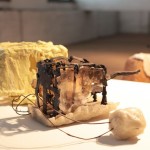
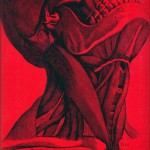
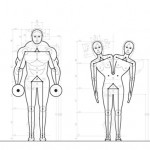
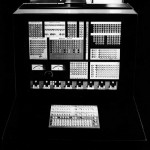
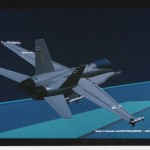
Great read. As his mentor and design tutor I particularly enjoyed the level of independency of this project and the attention to DETAIL and SCALE… the medieval looking apparatus as a whole and the delicacy of the needle thin carbon pencil. Despite being placed in a period of parametric dogmatism Nelson however, celebrates the currently unloved and forgotten Beaux-Art culture with wit and seriousness.
Stefan Lengen, Design tutor ESA
Hello Stefan,
thank you for the comment, with whom we completely agree. We also saw (in Léopold Lambert’s blog: http://thefunambulist.net/2010/12/21/students-mechanical-living-by-nelson-larroque/) another past project by Nelson that confirms the consistency and the autonomy of his research.
We read you are a design tutor at ESA. Me and Mariabruna Fabrizi have been for two semesters and we probably will be there again for the next one together with Prof. Luca Galofaro for his 4th year studio.
A good occasion to catch up if you like!
best and let’s keep in touch.
fosco lucarelli
mariabruna fabrizi